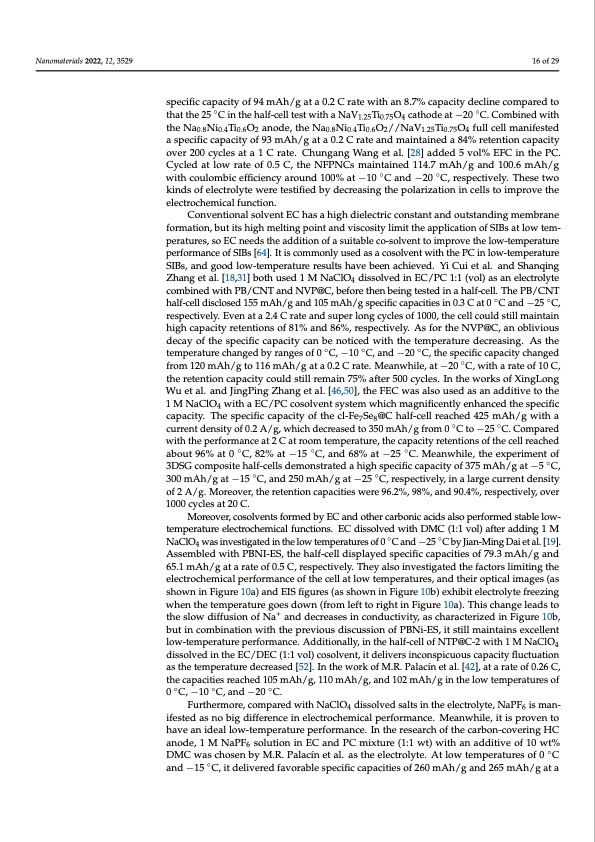
PDF Publication Title:
Text from PDF Page: 016
Nanomaterials 2022, 12, 3529 16 of 29 specific capacity of 94 mAh/g at a 0.2 C rate with an 8.7% capacity decline compared to that the 25 ◦C in the half-cell test with a NaV1.25Ti0.75O4 cathode at −20 ◦C. Combined with the Na0.8Ni0.4Ti0.6O2 anode, the Na0.8Ni0.4Ti0.6O2//NaV1.25Ti0.75O4 full cell manifested a specific capacity of 93 mAh/g at a 0.2 C rate and maintained a 84% retention capacity over 200 cycles at a 1 C rate. Chungang Wang et al. [28] added 5 vol% EFC in the PC. Cycled at low rate of 0.5 C, the NFPNCs maintained 114.7 mAh/g and 100.6 mAh/g with coulombic efficiency around 100% at −10 ◦C and −20 ◦C, respectively. These two kinds of electrolyte were testified by decreasing the polarization in cells to improve the electrochemical function. Conventional solvent EC has a high dielectric constant and outstanding membrane formation, but its high melting point and viscosity limit the application of SIBs at low tem- peratures, so EC needs the addition of a suitable co-solvent to improve the low-temperature performance of SIBs [64]. It is commonly used as a cosolvent with the PC in low-temperature SIBs, and good low-temperature results have been achieved. Yi Cui et al. and Shanqing Zhang et al. [18,31] both used 1 M NaClO4 dissolved in EC/PC 1:1 (vol) as an electrolyte combined with PB/CNT and NVP@C, before then being tested in a half-cell. The PB/CNT half-cell disclosed 155 mAh/g and 105 mAh/g specific capacities in 0.3 C at 0 ◦C and −25 ◦C, respectively. Even at a 2.4 C rate and super long cycles of 1000, the cell could still maintain high capacity retentions of 81% and 86%, respectively. As for the NVP@C, an oblivious decay of the specific capacity can be noticed with the temperature decreasing. As the temperature changed by ranges of 0 ◦C, −10 ◦C, and −20 ◦C, the specific capacity changed from 120 mAh/g to 116 mAh/g at a 0.2 C rate. Meanwhile, at −20 ◦C, with a rate of 10 C, the retention capacity could still remain 75% after 500 cycles. In the works of XingLong Wu et al. and JingPing Zhang et al. [46,50], the FEC was also used as an additive to the 1 M NaClO4 with a EC/PC cosolvent system which magnificently enhanced the specific capacity. The specific capacity of the cl-Fe7Se8@C half-cell reached 425 mAh/g with a current density of 0.2 A/g, which decreased to 350 mAh/g from 0 ◦C to −25 ◦C. Compared with the performance at 2 C at room temperature, the capacity retentions of the cell reached about 96% at 0 ◦C, 82% at −15 ◦C, and 68% at −25 ◦C. Meanwhile, the experiment of 3DSG composite half-cells demonstrated a high specific capacity of 375 mAh/g at −5 ◦C, 300 mAh/g at −15 ◦C, and 250 mAh/g at −25 ◦C, respectively, in a large current density of 2 A/g. Moreover, the retention capacities were 96.2%, 98%, and 90.4%, respectively, over 1000 cycles at 20 C. Moreover, cosolvents formed by EC and other carbonic acids also performed stable low- temperature electrochemical functions. EC dissolved with DMC (1:1 vol) after adding 1 M NaClO4 was investigated in the low temperatures of 0 ◦C and −25 ◦C by Jian-Ming Dai et al. [19]. Assembled with PBNI-ES, the half-cell displayed specific capacities of 79.3 mAh/g and 65.1 mAh/g at a rate of 0.5 C, respectively. They also investigated the factors limiting the electrochemical performance of the cell at low temperatures, and their optical images (as shown in Figure 10a) and EIS figures (as shown in Figure 10b) exhibit electrolyte freezing when the temperature goes down (from left to right in Figure 10a). This change leads to the slow diffusion of Na+ and decreases in conductivity, as characterized in Figure 10b, but in combination with the previous discussion of PBNi-ES, it still maintains excellent low-temperature performance. Additionally, in the half-cell of NTP@C-2 with 1 M NaClO4 dissolved in the EC/DEC (1:1 vol) cosolvent, it delivers inconspicuous capacity fluctuation as the temperature decreased [52]. In the work of M.R. Palacín et al. [42], at a rate of 0.26 C, the capacities reached 105 mAh/g, 110 mAh/g, and 102 mAh/g in the low temperatures of 0 ◦C, −10 ◦C, and −20 ◦C. Furthermore, compared with NaClO4 dissolved salts in the electrolyte, NaPF6 is man- ifested as no big difference in electrochemical performance. Meanwhile, it is proven to have an ideal low-temperature performance. In the research of the carbon-covering HC anode, 1 M NaPF6 solution in EC and PC mixture (1:1 wt) with an additive of 10 wt% DMC was chosen by M.R. Palacín et al. as the electrolyte. At low temperatures of 0 ◦C and −15 ◦C, it delivered favorable specific capacities of 260 mAh/g and 265 mAh/g at aPDF Image | Na Ion Batteries Used at Low Temperatures

PDF Search Title:
Na Ion Batteries Used at Low TemperaturesOriginal File Name Searched:
nanomaterials-12-03529-v4.pdfDIY PDF Search: Google It | Yahoo | Bing
Salgenx Redox Flow Battery Technology: Salt water flow battery technology with low cost and great energy density that can be used for power storage and thermal storage. Let us de-risk your production using our license. Our aqueous flow battery is less cost than Tesla Megapack and available faster. Redox flow battery. No membrane needed like with Vanadium, or Bromine. Salgenx flow battery
| CONTACT TEL: 608-238-6001 Email: greg@salgenx.com | RSS | AMP |